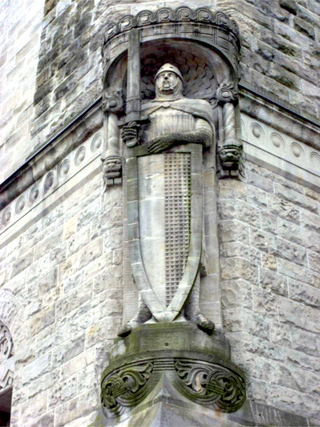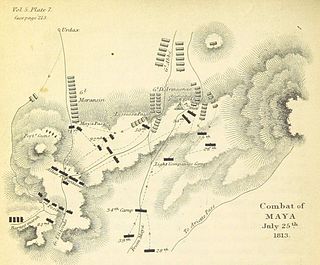
Roland was a Frankish military leader under Charlemagne who became one of the principal figures in the literary cycle known as the Matter of France. The historical Roland was military governor of the Breton March, responsible for defending Francia's frontier against the Bretons. His only historical attestation is in Einhard's Vita Karoli Magni, which notes he was part of the Frankish rearguard killed in retribution by the Basques in Iberia at the Battle of Roncevaux Pass.

Parkdale is a neighbourhood and former village in Toronto, Ontario, Canada, west of downtown. The neighbourhood is bounded on the west by Roncesvalles Avenue, on the north by the CP Rail line where it crosses Queen Street and Dundas Street. It is bounded on the east by Dufferin Street from Queen Street south, and on the south by Lake Ontario. The original village incorporated an area north of Queen Street, east of Roncesvalles from Fermanagh east to the main rail lines, today known as part of the Roncesvalles neighbourhood. The village area was roughly one square kilometre in area. The City of Toronto government extends the neighbourhood boundaries to the east, south of the CP Rail lines, east to Atlantic Avenue, as far south as the CN Rail lines north of Exhibition Place, the part south of King Street commonly known as the western half of Liberty Village neighbourhood.

Roncesvalles is a neighbourhood in the city of Toronto, Ontario, Canada, centred on Roncesvalles Avenue, a north–south street leading from the intersection of King and Queen Streets to the south, north to Dundas Street West, a distance of roughly 1.7 kilometres. It is located east of High Park, north of Lake Ontario, in the Parkdale–High Park provincial and federal ridings and the municipal Ward 4. Its informal boundaries are High Park to the west, Bloor Street West to the north, Lake Ontario/Queen Street West to the south and Lansdowne Avenue/rail corridor to the east. Originally known as "Howard Park", most of this area was formerly within the boundaries of Parkdale and Brockton villages and was annexed into Toronto in the 1880s.

The Battle of Roncevaux Pass in 778 saw a large force of Basques ambush a part of Charlemagne's army in Roncevaux Pass, a high mountain pass in the Pyrenees on the present border between France and Spain, after his invasion of the Iberian Peninsula.

Roncesvalles Pass, Ronceval Pass or Roncevaux Pass is a high mountain pass in the Pyrenees near the border between France and Spain. The pass itself is entirely in Spain.

Roncesvalles is a small village and municipality in Navarre, northern Spain. It is situated on the small river Urrobi at an altitude of some 900 metres (3,000 ft) in the Pyrenees, about 4 kilometres (2.5 mi) from the French border as the crow flies, or 21 kilometres (13 mi) by road.

Roncesvalles Avenue is a north–south minor arterial street in Toronto, Ontario, Canada. It begins at the intersection of Queen Street West, King Street West and the Queensway running north to Dundas Street West. At its southern starting point, King Street West traffic continues northward onto Roncesvalles Avenue unless the traffic turns east or west onto Queen Street West or the Queensway. At its northern end point, traffic continues onto Dundas Street, which is essentially a straight-line northern extension of Roncesvalles.

Sunnyside is a lakefront district in Toronto, Ontario, Canada. It includes a beach and park area along Lake Ontario's Humber Bay, from west of Exhibition Place to the mouth of the Humber River. The area has several recreation uses, including rowing clubs, sports clubs, picnic areas, playgrounds, a nightclub, a bathing pavilion and public pool. The area is a 3 kilometres (1.9 mi) long strip along the lakeshore, bounded by the Gardiner Expressway and rail lines, which separate it from the Parkdale, Roncesvalles and Swansea neighbourhoods to the north. The name originates in a local farm owned by John Howard, which was situated just to the north, on the location of the current St. Joseph's Health Centre hospital.

The Battle of the Pyrenees was a large-scale offensive that was launched on 25 July 1813 by Marshal Nicolas Jean de Dieu Soult from the Pyrénées region on orders of Emperor Napoleon in the hope of relieving French garrisons under siege at Pamplona and San Sebastián. After initial success, the offensive ground to a halt in the face of increased allied resistance under the command of Arthur Wellesley, Marquess of Wellington. Soult abandoned the offensive on 30 July and headed toward France after he had failed to relieve either garrison.

504 King is an east–west Toronto streetcar route in Ontario, Canada. It serves King Street in Downtown Toronto as well as Broadview Avenue on the east end and Roncesvalles Avenue on the west end of the line. The route consists of two overlapping branches: 504A between Line 2 Bloor–Danforth's Dundas West station and Distillery Loop, and 504B between Broadview station – also on Line 2 – and Dufferin Gate Loop. The two branches overlap on King Street between Dufferin and Sumach streets, both passing St. Andrew station and King station on subway Line 1 Yonge–University.

Luzaide is a town in Navarre, northern Spain, located on the French border and just a few kilometers from the road frontier in the French village of Arnéguy.

Brockton Village is a former town, and now the name of a neighbourhood, in Toronto, Ontario, Canada. It comprises a section of the old Town of Brockton which was annexed by the City of Toronto in 1884.
Colonel Walter O'Hara was a prominent member of the British army in the 19th century, participating in battles fighting Napoleon, before immigrating to Toronto, Ontario, Canada, where he participated in the Rebellions of 1837 on the side of the government, defeating the rebels of William Lyon Mackenzie.

The Battle of Maya saw an Imperial French corps led by Jean-Baptiste Drouet, Comte d'Erlon attack the British 2nd Division under William Stewart at the Maya Pass in the western Pyrenees. Despite being surprised, the outnumbered British soldiers fought stoutly, inflicting greater losses on the French than they suffered themselves. By the afternoon, the French gained the upper hand and were pressing forward, but the late arrival of a brigade from the British 7th Division stabilized the situation. The British forces slipped away under the cover of night and the French did not pursue effectively. The Peninsular War battle at Maya was part of the Battle of the Pyrenees, which ended in a significant Anglo-Allied victory.

The Battle of Roncesvalles was a battle between French and Anglo-Portuguese forces during the Peninsular War (1808–1814).

The Via Podiensis or the Le Puy Route is one of the four routes through France on the pilgrimage to the tomb of St. James the Great in Santiago de Compostela in Galicia in northwest Spain. It leaves from Le-Puy-en-Velay and crosses the countryside in stages to the basque village of Ostabat. Near there it merges with two of the other routes, the via Turonensis and the via Lemovicensis which merge a little earlier.

Ab Asturica Burdigalam was a Roman road that linked the towns of Asturica Augusta in Gallaecia and Burdigala in Aquitania.
Marsile is a character in the French heroic poem The Song of Roland. He is the Muslim king of the Saracens and of Saragossa. He first appears in Stanza 1, asking his barons for counsel because he is losing the war against Charlemagne. He readily accepts Blancandrin's proposal of surrender, and agrees to Ganelon's scheme after testing his worth and persuasion from his wife Bramimonde and his nobility (32–52). He takes part in the Battle of Roncevaux Pass, kills Bevon, Lord of Beaune and Dijon, Yvoire, Yvon and Gerald of Roussillon, before Roland cuts off Marsile's right hand and the head of his son, Jurfaleu the Blond, and Marsile is forced to flee (142) to Saragossa (187). Bound to his bed with his injuries, he summons help from Baligant (189), places Spain in Baligant's care (202), and later dies of his wounds, his army having been destroyed.

The Battle of Orbaizeta was fought from 15 to 17 October 1794 during the War of the Pyrenees, between the French Army of the western Pyrenees led by Bon-Adrien Jeannot de Moncey and Spanish forces under the command of Pedro Téllez-Girón, 9th Duke of Osuna. Part of the wider French Revolutionary Wars, this engagement was fought over a wide area to the northwest and northeast of Pamplona in Navarre and ended in a French victory. The Spanish defenders gave up territory to the north of Pamplona, including a number of strategic locations.
Iturissa was a Roman town in north-west Spain in the province of Hispania Tarraconensis, now the province and autonomous community of Navarre. Iturissa was mentioned by Ptolemy in the second century as "a town of the Vascones."
















